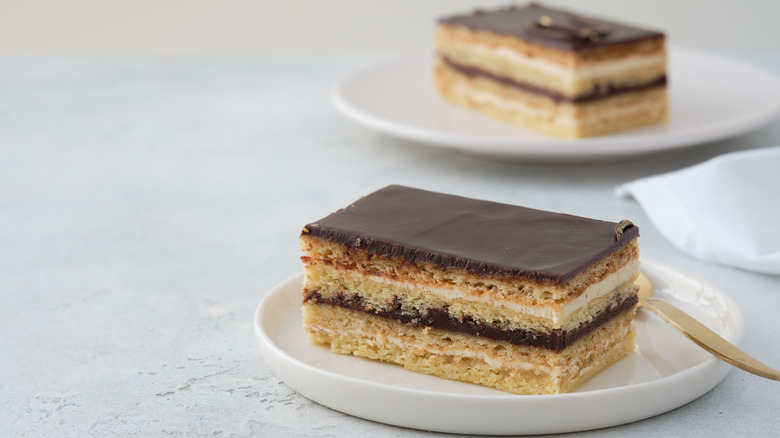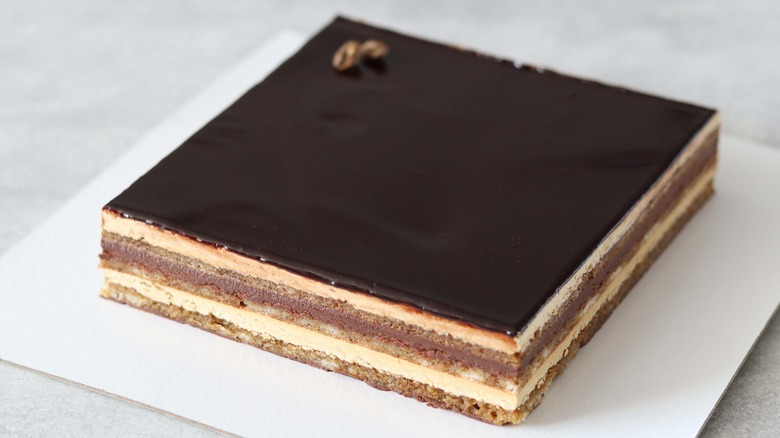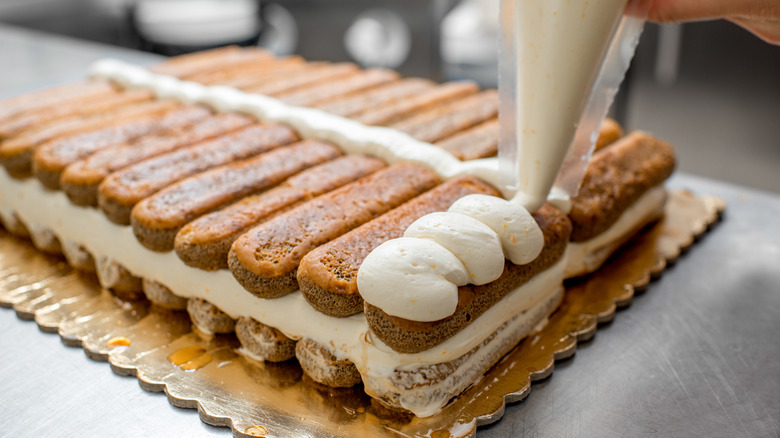What Sets Opera Cake Apart From Its Culinary Twin Tiramisu
If you've ever seen an opera cake (aka gâteau opéra) while walking through the streets of Paris or browsing your local French bakery, you've probably also noticed its defined coffee-soaked layers sandwiched between pillowy buttercream and chocolate ganache. The appearance of this quintessentially French cake, though striking on its own, at first glance can easily be mistaken for the Italian classic, tiramisu. While tiramisu and opera cake share a layered appearance and the beauty of a coffee-soaked sponge, the traditional ingredients used to make each dessert are quite different.
What sets opera cake apart is its light and airy almond flour sponge cake, coffee-flavored French buttercream, and rich dark chocolate layers throughout each delicate bite. Generally a straightforward recipe, the cake, developed at Dalloyau bakery in 1950s Paris by French pastry chef Cyriaque Gavillon, requires some familiarity with French baking techniques like custardy French buttercream (if prepared traditionally). Tiramisu, on the other hand, is known for its simplicity and proudly Italian ingredients like ladyfinger sponge cookies, mascarpone cheese, Marsala wine, and, of course, coffee.
Opera cake has distinct layers, and is more chocolate-forward
Both opera and tiramisu cakes are perfect for soaking in coffee syrup, which lets the flavors develop and deepen as they sit — largely due to the texture of their sponge bases. Opera cake is prepared by making thin rectangular layers of almond cake, called jaconde sponge, while the base for tiramisu is ladyfinger sponge cookies. Though the ingredients and flavors vary (most notably, opera cake's joconde has a nuttiness paired with a richness from the layers of dark chocolate, while tiramisu is more coffee and cream-forward with just a dusting of unsweetened cocoa on top), both sponges provide a light airiness achieved by folding in a meringue made of whipped egg whites and sugar.
An opera cake's layers are typically precise, thin, and even, making for a chic appearance. Though it's quite impressive to see the six or eight layers of sponge, cream, and ganache, some bakers emphasize the chocolate even further by covering the whole cake in chocolate — which means the beautiful layers are revealed only when the cake is cut into. For tiramisu, the domed ladyfingers are soaked in coffee and positioned prior to adding the layers of mascarpone filling, giving way to a more scalloped cross-sectional look. Plus, tiramisu can be prepared in a number of ways — the classic layer cake is one, but some also prepare the dessert as a trifle or in individual serving cups.
Both desserts allow for culinary creativity
It can be intimidating to take on the task of making such iconic fare as opera cake and tiramisu. The good news is both desserts are open to culinary interpretation. For instance, each typically includes liquor mixed in with the coffee syrup, but you can mix up the spirits to your taste — or omit the booze altogether. If you are spiking your syrup, add orange liquor to the coffee soak to pair perfectly with your opera cake's dark chocolate ganache. While Sicilian Marsala wine is commonly used for tiramisu, you could simply swap in rum or port. And though out of the two cakes, opera cake is certainly the more chocolate-forward one, you could always choose to add a decadent layer or two of silky ganache to tiramisu.
As for baking techniques for opera cake, some recipes call for a French buttercream (made by cooking egg yolks in a hot sugary syrup), which might be out of your expertise — but don't let that hold you back. Instead, you could whip instant coffee with heavy cream to make a fluffy java filling, or craft an American buttercream using butter, instant coffee, and powdered sugar — just note that it will be sweeter and heavier than the French version of buttercream. Whatever variations you make, remember to have fun with the process and embrace the magic and sophistication of a Parisian opera.


